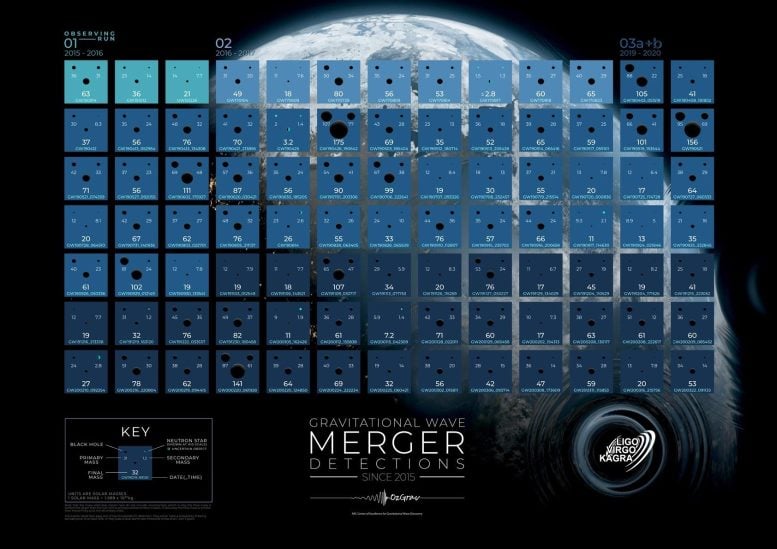An artist’s impression of two black holes about to collide and merge.
A team of international scientists, including researchers from The
Graphic depicting the gravitational wave mergers detected since the historic first discovery in 2015. Credit: Carl Knox (OzGrav, Swinburne University of Technology)
ANU is one of the key players in the international team making the observations and developing the sophisticated technology to hunt down elusive gravitational waves across the vast expanse of the Universe.
Distinguished Professor Susan Scott, from the ANU Centre for Gravitational Astrophysics, said the latest discoveries represented “a tsunami” and were a “major leap forward in our quest to unlock the secrets of the Universe’s evolution.”
“These discoveries represent a tenfold increase in the number of gravitational waves detected by LIGO and Virgo since they started observing,” Distinguished Professor Scott said.
“We’ve detected 35 events. That’s massive! In contrast, we made three detections in our first observing run, which lasted four months in 2015-16.
“This really is a new era for gravitational wave detections and the growing population of discoveries is revealing so much information about the life and death of stars throughout the Universe.
“Looking at the masses and spins of the black holes in these binary systems indicates how these systems got together in the first place.
“It also raises some really fascinating questions. For example, did the system originally form with two stars that went through their life cycles together and eventually became black holes? Or were the two black holes thrust together in a very dense dynamical environment such as at the center of a galaxy?”
Distinguished Professor Scott, who is also a Chief Investigator of the ARC Centre of Excellence for Gravitational Wave Discovery (OzGrav), said the continual improvement of gravitational wave detector sensitivity was helping drive an increase in detections.
“This new technology is allowing us to observe more gravitational waves than ever before,” she said.
“We are also probing the two black hole mass gap regions and providing more tests of Einstein’s theory of general relativity.
“The other really exciting thing about the constant improvement of the sensitivity of the gravitational wave detectors is that this will then bring into play a whole new range of sources of gravitational waves, some of which will be unexpected.”
